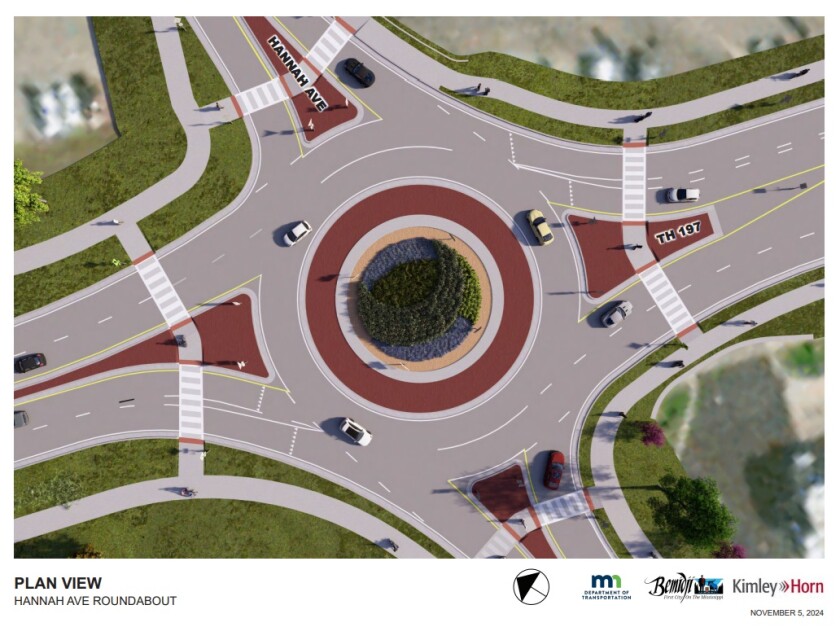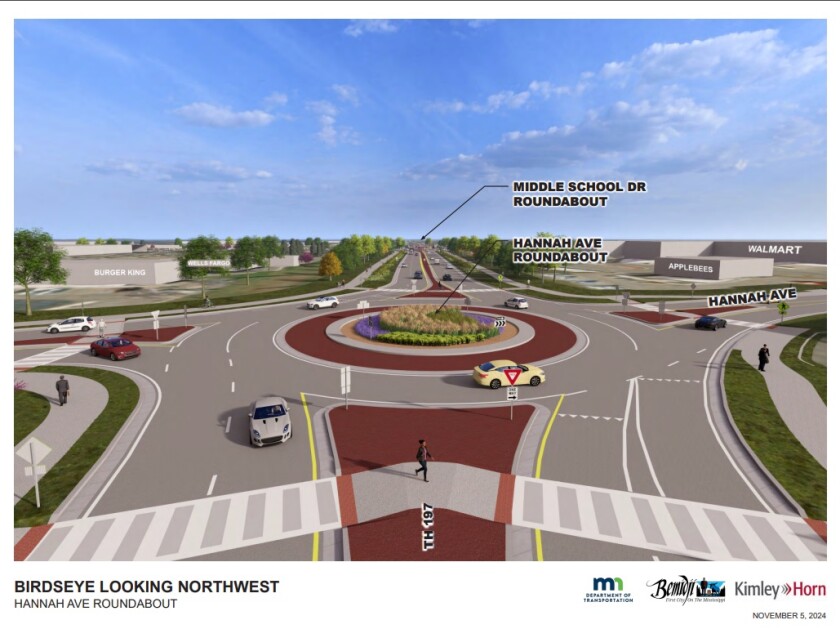BEMIDJI — The Bemidji City Council convened Tuesday evening for an update on the State Highway 197 project, an initiative in the making since 2018.
City Engineer Sam Anderson presented council members with fresh renderings of the design plans, particularly highlighting new landscaping choices aimed at enhancing both the visual appeal and functionality of the corridor, while also being mindful of the burden of upkeep.
ADVERTISEMENT
The project’s planned transformation of the highway — with roundabouts, landscaped medians and multi-use paths — has sparked strong community interest, as the Minnesota Department of Transportation, city officials and local businesses work together to address practical needs and refine the project’s design.
The State Highway 197 project has been in the works since initial corridor studies began in 2018, and the design has evolved in response to community input.
Over the years, MnDOT has conducted public engagement sessions and met with dozens of local business owners to gather feedback on design priorities and concerns.
The project’s goals are to improve safety, streamline traffic flow and support both vehicle and pedestrian accessibility along a critical stretch of highway running through Bemidji’s city center from Gillett Drive near the airport to Hannah Avenue.
In recent years, MnDOT and the council explored various options, including roundabout installations at major intersections, such as the entrances to Menards and Hannah Avenue, and the addition of a structural snow fence near the airport to manage winter conditions.
The latest significant update took place during a meeting on Sept. 16 when the council held a public hearing to present and discuss design elements in greater detail. That session allowed MnDOT representatives and the council to field community concerns and refine project elements.
The project is financially backed by an $18 million Rebuilding American Infrastructure with Sustainability and Equity grant from the U.S. Department of Transportation, along with an additional $5 million matching grant, ensuring the project can be completed as designed without exceeding the set budget.
ADVERTISEMENT
Landscape ideas
During Tuesday's update, Anderson shared the latest design renderings focusing on landscaping options chosen for resilience in Bemidji’s climate.
“Everything that you’re seeing tonight that’s being proposed is species and plants and shrubs and grasses that are intended to be very salt tolerant and very stable in these environments, even with these conditions that we’re looking with being near a highway,” he explained.
The landscaping approach prioritizes low-maintenance plant selections.
“The goal here is to really try and build that out and see those plants really overtake that center and be something that comes back every year without a lot of effort from staff,” Anderson added.

Larger roundabouts, such as the one on Middle ÍáÍáÂţ» Drive, may include decorative elements like a “boulder or feature,” Anderson said, whereas the MnDOT-controlled roundabouts will keep things minimal.
“We’re not looking at any kind of major fixed objects, trees, boulders, as that’s a big no-no when it comes to MnDOT,” Anderson added.
Ward 1 Councilor Gwenia Fiskevold Gould expressed appreciation for the design’s aesthetic value but inquired about low-maintenance enhancements for smaller roundabouts.
ADVERTISEMENT
“Is it possible to have a design in the concrete that’s all flat, that wouldn’t be obstructive?” she asked, suggesting a decorative concrete that would minimize upkeep while adding visual interest.

Anderson responded with reluctance to this idea, because sometimes drivers may not know they are allowed to drive over that portion of the roundabout.
Ward 3 Councilor Ron Johnson commented on the aesthetic foliage and shrubs planned for roundabouts, suggesting that visibility might not be a significant issue since most drivers focus on navigating the roundabout rather than what’s in the center.
“I must have gone on five or six roundabouts this weekend, and I can’t even tell you what was in the middle of them,” he remarked. “When I’m driving around it, I’m looking to go around,” Johnson explained.
Ward 4 Councilor Emelie Rivera followed up on Johnson’s comments by proposing potential compromises to ease upkeep demands.
“Is it possible, with the upkeep piece of it, if we narrow the diameter of the green space and had more of like a larger area of the colored concrete, that might reduce some of that?” Rivera asked, adding that alternatives could include more cost-effective mulch maintenance.

At-Large Councilor Audrey Thayer shared her support for pedestrian safety and walkability improvements, particularly sidewalks along the corridor.
ADVERTISEMENT
“There are usually two or three (children) with a parent going over to Walmart, and I think that concerns me, for the safety of family and the walkability of our city...” she said.
Thayer emphasized the need for sidewalks in nearby residential areas, adding that “any areas where the city could add sidewalks would be really helpful."
As the meeting moved toward its conclusion, Anderson wrapped up with a clear reminder of the potential maintenance challenges.

"I just want to make sure that we're all clear on what we're getting," Anderson said, acknowledging concerns about the project’s appearance.
"There’s a lot of concerns that our city is not going to look very presentable when we come into town. This is kind of a stab at that, while still keeping the low maintenance in mind," he continued, though he cautioned, "ultimately, there is a risk that it does get overgrown, and we've got to pivot."











